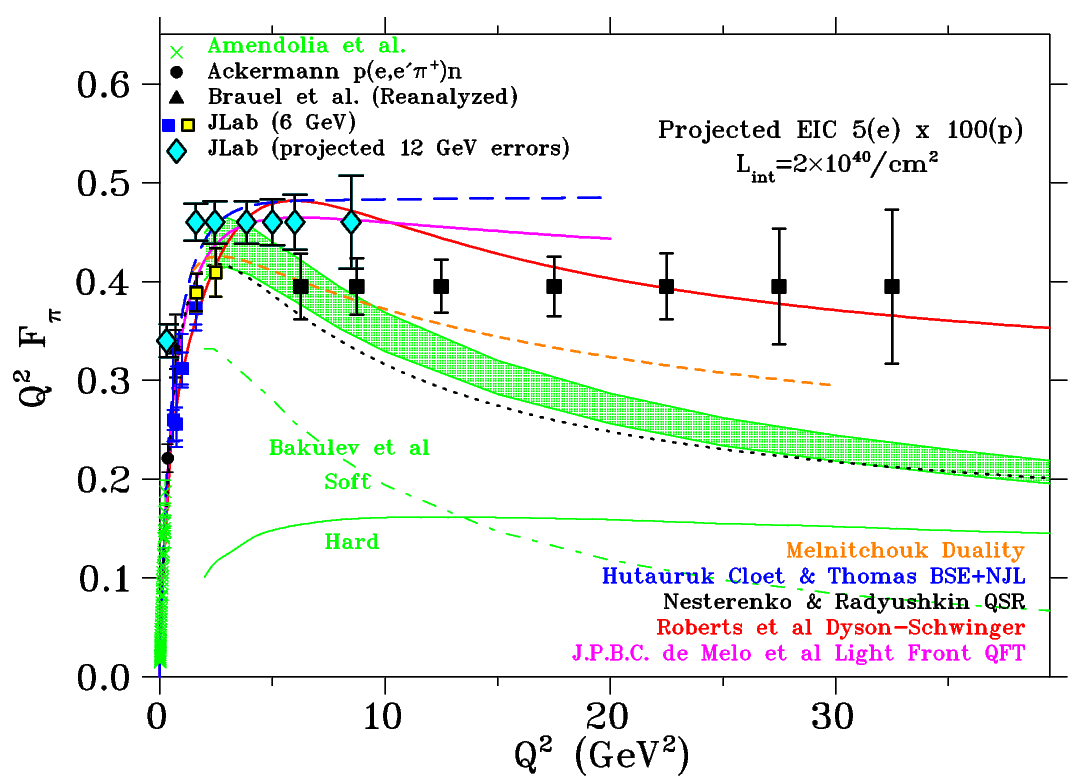The nature of the strong force at long distances, where quark confinement
dominates, is one of the major unsolved problems of modern physics. In fact,
the Fields Institute and the Clay Institute have both listed the solution of
how color confinement permits only bound states of massless gluons, forming
only massive hadrons (i.e. mass gap within Yang-Mills quantum theory) as one of
their Millenium Prize problems. One of the complications is that in the
confinement regime, the quark-gluon interaction is too strong for perturbative
methods to be reliably applied, and so far QCD can only be used as a basis for
either model development or numerical solutions such as Lattice QCD, both of
which must be guided by experimental data.
Experimental studies using inclusive electron scattering at high momentum and
energy transfer have provided important information on the elementary
interactions of quarks and gluons. However, our understanding is
fragmented. Our program of experimental studies is intended to better our
understanding of QCD in the strongly interacting, non-perturbative regime,
where quark (color) confinement dominates.
Jefferson Lab (JLab) is the world's premier nuclear physics facility, with
intense, high quality, polarized electron beams of energy up to 12 GeV,
optimized to perform a wide variety of hadron structure measurements, as
alluded to above. The newly upgraded facilities allow a new
generation of very promising and very interesting experiments to study the
structure of hadronic matter. These are described in further detail
below. In parallel, we are constructing detectors for
SoLID, more information here, and making preparations for
the Electron-Ion Collider, a new facility that will be constructed at
Brookhaven National Laboratory, in New York state this decade. This work is
described here.
Various News Items about our Work:
The first set of experiments are taking place in Hall C, and use the new SHMS
spectrometer in coincidence with the HMS spectrometer in Hall C. The
requirements upon this 11 GeV/c spectrometer are 5.5 degree forward angle
capability, and good systematic error control in the L/T separation at high
luminosity. Our responsibilities included the SHMS heavy gas
(C4F10) Cerenkov detector and assistance with the
spectrometer commissioning. E12-10-006B will use SoLID, which is
described below.
We have a large quantity of data on hand, and there are LOTS of opportunities to
contribute!
The long-term interest in the π+
electric form factor is due to Farrar and Jackson [PRL 43(1979)246], who
showed that Fπ is rigorously calculable in perturbative
QCD (pQCD). Their answer is exact and model-independent at
infinite Q2, dependent only on the assumption of quark
asymptotic freedom. Such a reliable result is rare in QCD. However, it is not
known at what region of Q2 the value
of Fπ will reflect the onset of pQCD
and this value, as well as the actual behavior of
Fπ as a function of Q2 in the non-perturbative
transition region, are important tests of our understanding of QCD in bound
hadron systems. Because of the smaller number of valence quarks in the pion,
the asymptotic regime will be reached at lower values of Q2
than for the nucleon form factors, so the π+ form factor offers
our best hope of directly observing QCD's transition from strong confinement at
long distance scales to asymptotic freedom at short distances.
Research Program:
1. The Central Scientific Question
The Standard Model of particle physics now lies at the center of much nuclear
physics research. One of the basic elements of the Standard Model, the
existence of quarks and gluons, was first inferred from the spectrum of
elementary particles and from electron-scattering experiments. Susequently,
Quantum Chromo-Dynamics (QCD) was developed to describe them. Just as the
formulation of Maxwell's equations led to a quantitative understanding of
electromagnetic phenomena in the late 19th century, so the development of QCD a
century later has provided the theoretical foundation for the understanding of
many strong interaction phenomena.
2. Jefferson Lab Measurements
I have been involved in the JLab scientific program for approximately 25 years.
The table below lists the 12 GeV experiments that I am playing a leadership
role in.
One of the obstacles to our improved comprehension of non-perturbative QCD has
been a lack of quality data, particularly for the Deep Exclusive electron
scattering reactions, which provide the clearest picture of the inner workings
of QCD. Jefferson Lab enables these studies with its continuous, high
luminosity electron beams, and detectors with good particle identification and
reproducible systematics. By making precision measurements of this nature, we
hope to better make the elusive connection between the underlying quark/gluon
dynamics and the observed structures of mesons and nucleons, and ultimately to
understand the origin of hadronic mass.
Experiment Number
Spokespersons (contact person underlined)
Experiment Title
Scientific Priority Rating
PAC Days Awarded
Anticipated Running Time (assuming 50% data taking efficiency)
E12-06-101 D. Gaskell, G.M. Huber
Measurement of the Charged Pion Form Factor to High Q2
[Superceded by E12-19-006]
A 52 days 104 days (completed)
E12-07-105 T. Horn, G.M. Huber
Scaling Study of the L-T Separated Pion Electroproduction Cross-Section at
11 GeV
[Superceded by E12-19-006]
A- 36 days 72 days (completed)
E12-09-011 T. Horn, G.M. Huber,
P. Markowitz
Studies of L-T Separated Kaon Electroproduction Cross-Section from 5-11
GeV
B+ 40 days 80 days (partially completed)
E11-002 E.J. Brash, G.M. Huber,
R. Ransome, S. Strauch
Proton Recoil Polarization in the 4He(e,e'p)3H,
2H(e,e'p)n, and 1H(e,e'p) Reactions
B+ 37 days 74 days
E12-10-006B Z. Ahmed, G.M. Huber,
Z. Ye
Measurement of Deep Exclusive π- Production using a
Transversely polarized 3He Target and the SoLID Spectrometer
Run Group has A priority 48 days 96 days
E12-19-006 D. Gaskell, T. Horn, G.M.
Huber Study of L--T Separated Pion Electroproduction Cross
Section at 11 GeV and Measurement of the Charged Pion Form Factor to High
Q2
[Supercedes E12-06-101 and E12-07-105]
A 88 days 176 days (completed)
E12-20-007 G.M. Huber, W.B. Li, J. Stevens
Backward-angle Exclusive π0 Production above the
Resonance Region
B 29 days 58 days (beam request submitted)
List of Physics Channels available for Analysis
3. Deep Exclusive Meson Production @ Hall C of Jefferson Lab

3a. Pion and Kaon Electric Form Factors
Central to the problem of the transition of QCD from long to short distance
scales is the pion, which has a particularly important role in nature. As the
lightest meson, with a single valence quark and a single valence antiquark, it
is responsible for the long range character of the strong interaction that
binds the atomic nucleus. The underlying rules governing the strong interaction
are believed to be left-right (chirally)-symmetric. If this were completely
true, the pion would have no mass. But the chiral symmetry of massless QCD is
broken dynamically by quark-gluon interactions (Dynamical Chiral Symmetry
Breaking, DCSB) and explicitly by inclusion of light quark masses, giving the
pion mass. The pion is seen as key to confirm the mechanisms that dynamically
generate >98% of the mass of the visible universe and central to the effort to
understand hadron structure. With such strong theoretical motivation, it is
vital to the study the pion electric form factor (Fπ),
which encodes our knowledge of the distribution of quarks and gluons within it.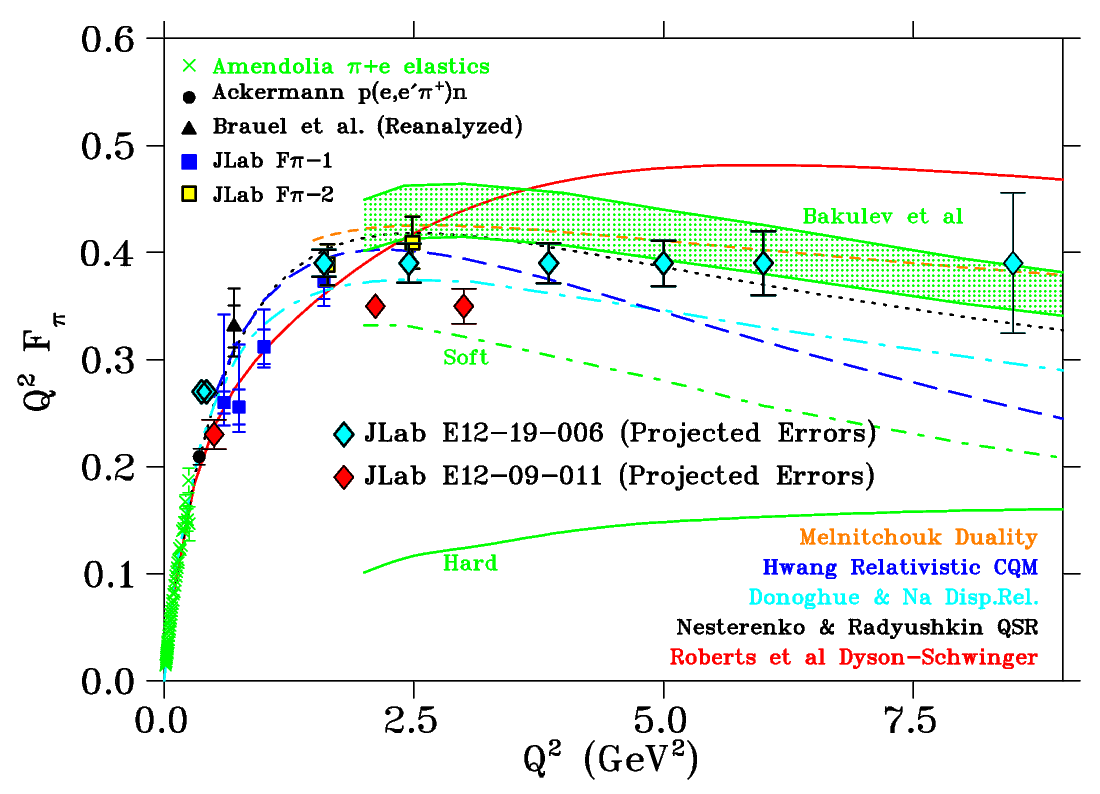
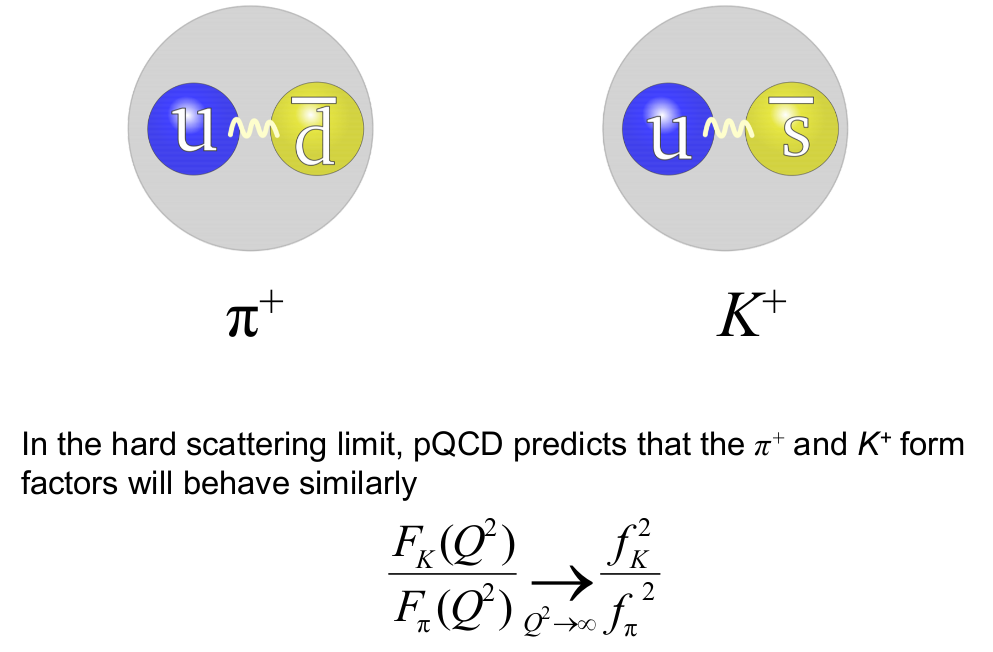
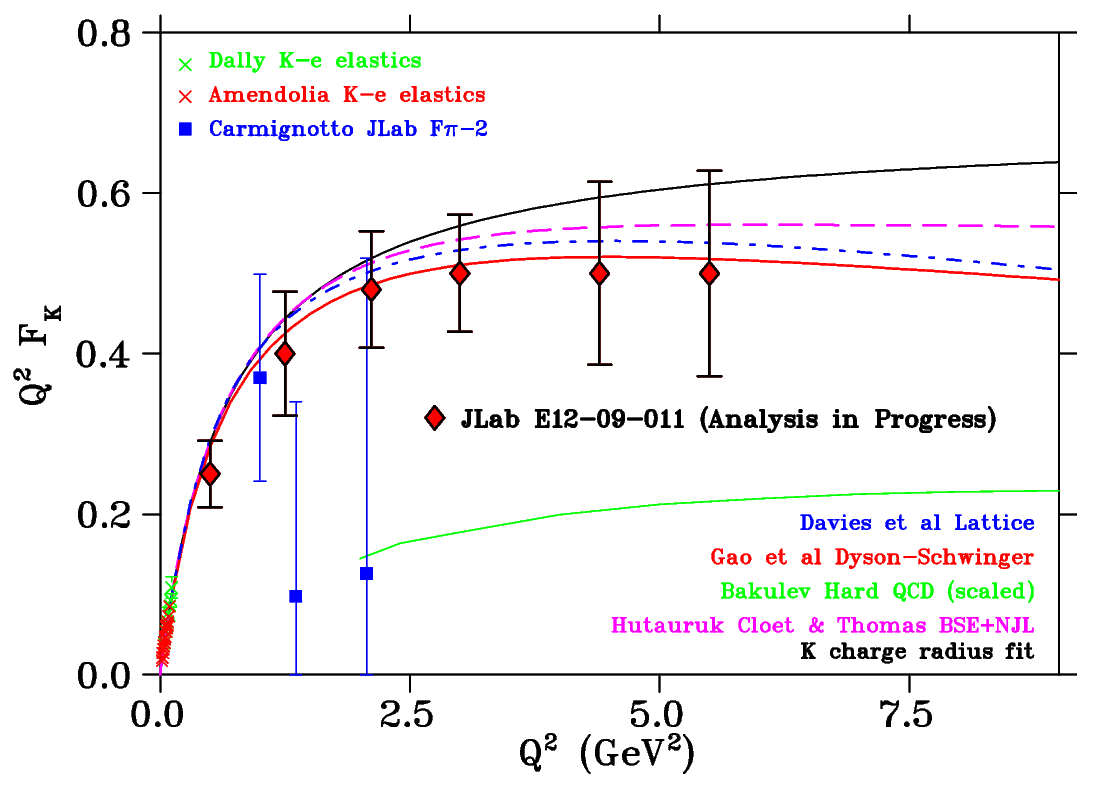
3b. QCD Factorization Tests using Exclusive Pion and Kaon Production
Our two related 12 GeV experiments [E12-19-006, E12-09-011] will allow a direct comparison of the scaling properties of Deep Exclusive K+ and π+ electroproduction ,to better understand the onset of QCD factorization in the transition from hadronic to partonic degrees of freedom. In particular, if the QCD factorization regime has been reached in a given measurement, the longitudinal cross section will dominate over the transverse, and the separated cross sections will scale according to the 1/Qn expectations of pQCD. For Deep Exclusive Meson production, quark counting rules predict σL proportional to 1/Q6, and σT falling at least as fast as 1/Q8. In 2007, we published an initial scaling study of the 1/Qn dependences of charged pion electroproduction at fixed x. The study indicated only partial agreement with the factorization expectations, but the error bars on the fit were compromised by the limited kinematic range available at 6 GeV. Since the extraction of GPDs from Deep Exclusive electron scattering data relies on the factorization of the scattering amplitude into hard and soft processes, we have proposed to extend these studies to a broader kinematic range. We will also perform measurements of the longitudinal cross section at low -t to determine whether the K+ elastic form factor can be inferred from these data. If the studies are favorable, we would perform the first-ever extraction of the K+ form factor above Q2=0.35 GeV2. The K+ experiment acquired data in 2018-2019, and the π+ experiment acquired data in 2021 and 2022.
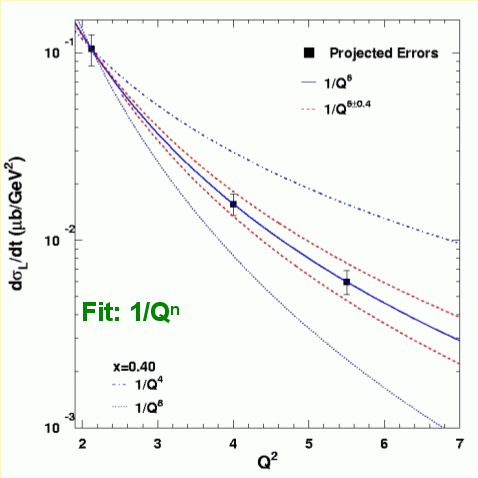
3c. u-channel Deep Exclusive Vector Meson Electroproduction
Backward-angle (-u~ 0) meson electroproduction has been previously ignored, but is anticipated to offer complementary information to forward-angle (-t~ 0) meson electroproduction. This is particularly interesting with the development of the collinear-factorization approach of QCD, which has drawn attention to Transition Distribution Amplitidues (TDAs) as a new probe of hadronic structure. TDAs directly probe the three-quark plus sea q-qbar component in the nucleon's wave function. The kinematic domain demanded by the collinear factorization framework is unique. The meson must be emitted antiparallel to the virtual γ*, at extreme backward angle.
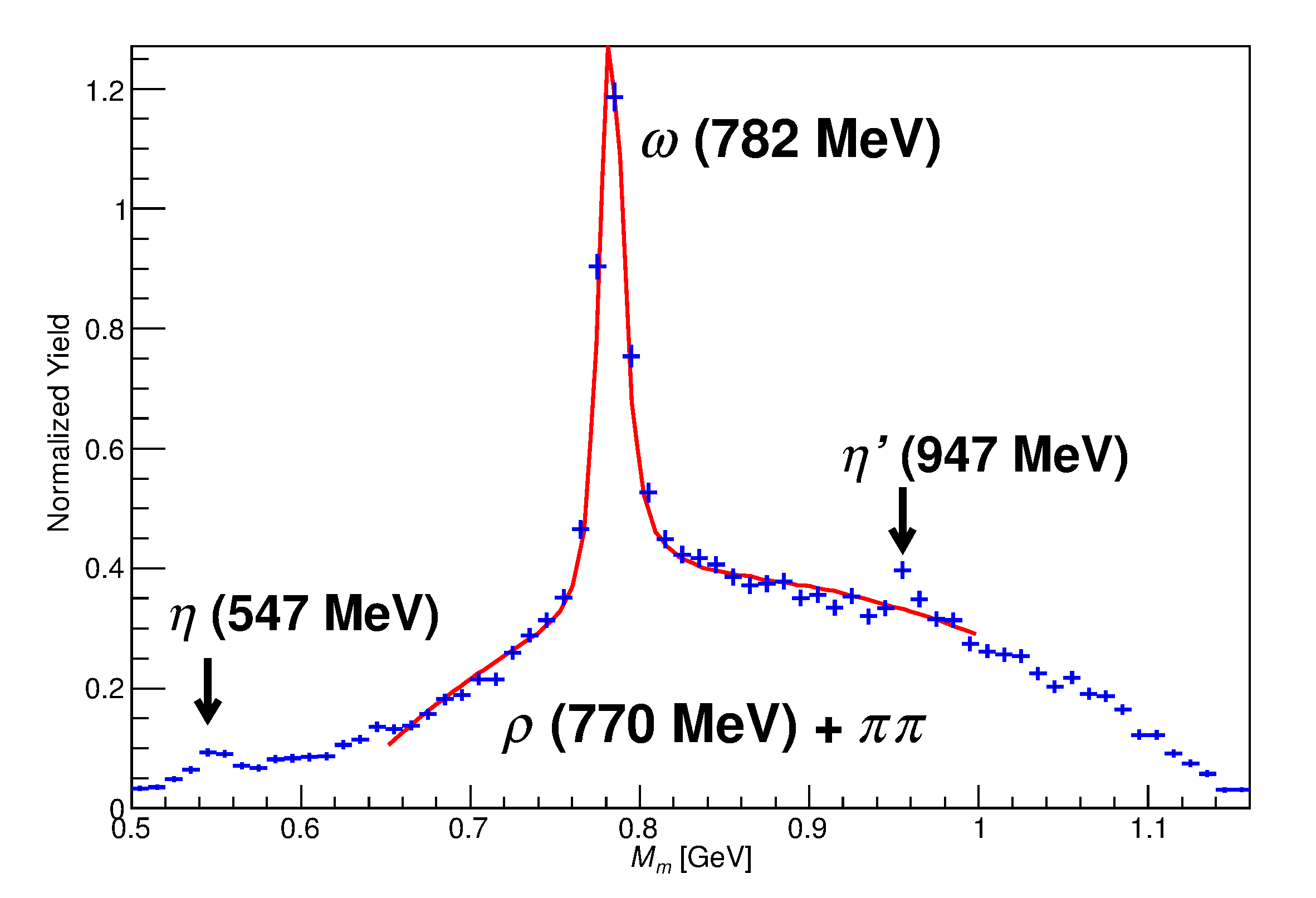
We acquired further backward-angle ω and φ data in the 12 GeV pion form factor experiment, including the Q2-dependence up to 6 GeV2. Our new experiment (E12-20-007) will measure exclusive π0 electroproduction in u-channel kinematics. The three objectives of the 12 GeV studies are: (i) to establish the existence of a significant backward-angle cross section peak for multiple reaction channels and over a wide kinematic range; (ii) extract the dependence of the separated cross sections upon momentum transfer, to study the transition from soft to hard scattering, similar to described above for π+ production; and (iii) establish the applicable kinematic range of the backward angle factorization scheme. We also have an idea to use this reaction to probe the phenomenon of Color Transparency in a new experiment.
4. Transverse Single Spin Asymmetry with SoLID
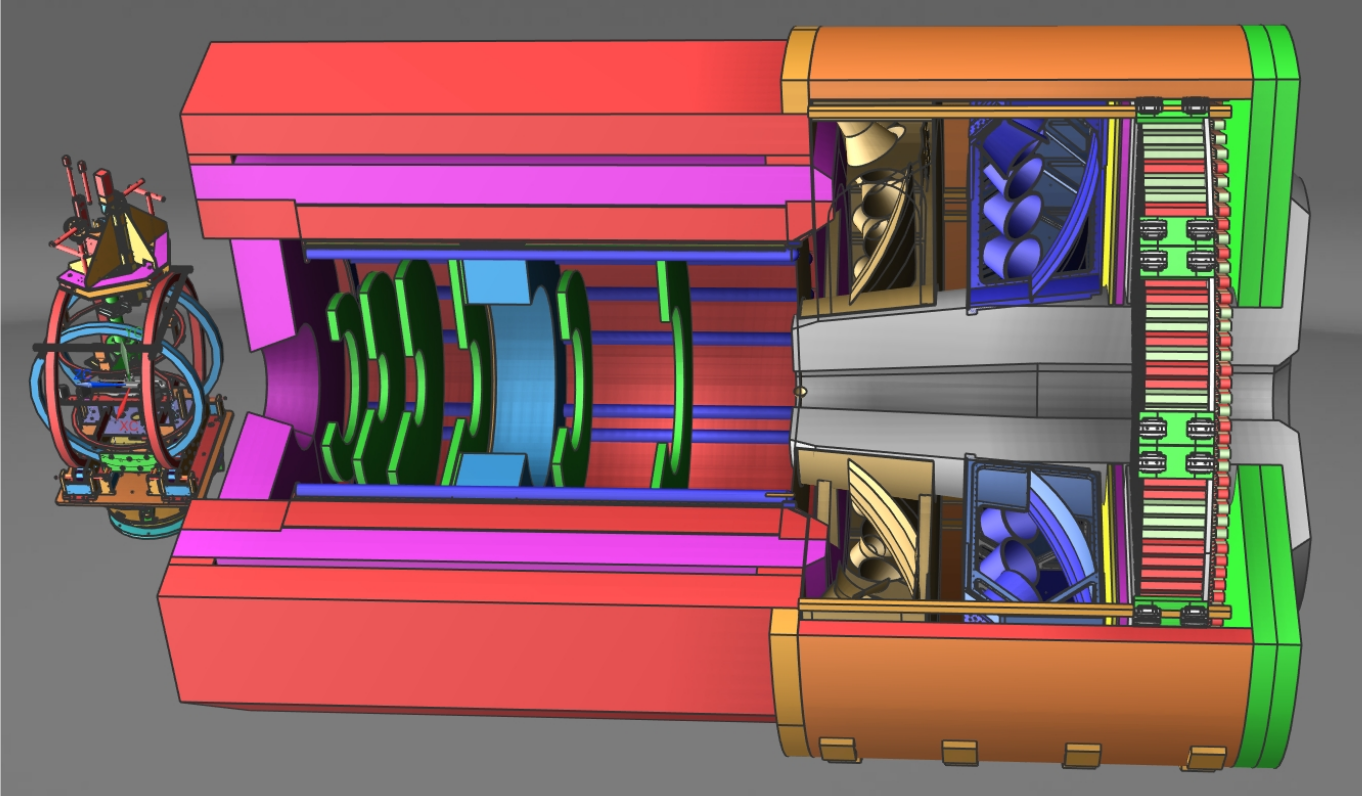
4a. Introduction to the SoLID Science Program
The Solenoidal Large Intensity Device (SoLID) is a new experimental apparatus planned for Hall A of Jefferson Lab. SoLID will combine large angular and momentum acceptance with the capability to handle very high data rates at high luminosity. With a slate of approved high-impact physics experiments, SoLID will push JLab to a new limit at the QCD intensity frontier that will exploit the full potential of its 12 GeV electron beam.SoLID can accommodate a variety of experimental configurations for a broad spectrum of physics, leading to a rich physics program. Briefly, these include:
- Measurements of Transverse- Momentum-Dependent Distributions (TMDs), which describe the three-dimensional structure of the nucleon in momentum space via Semi-Inclusive Deep Inelastic Scattering (SIDIS) with polarized 3He and proton targets.
- An experiment aiming to understand the origin of the proton mass via measurements of near-threshold photo-production and electro-production of theJ/$psi; meson.
- A test the electroweak sector of the Standard Model at low energy and study hadronic physics in the high-x region through measurements of Parity-Violating Deep Inelastic Scattering (PVDIS), and a study of the flavor dependence of the EMC effect using PVDIS with a 48Ca target.
- A study of hadronic physics with two-photon exchange via a measurement of the beam-normal single-spin asymmetry in DIS.
- Measurements of Deep Exclusive Meson Production (DEMP) and Time-like Compton Scattering (TCS), which access the Generalized Parton Distributions (GPDs) and improve our knowledge of the spatial three-dimensional structure of the nucleon.
4b. Our detector contributions to SoLID
The design of SoLID has been vetted by several JLab Director's reviews and a US Department of Energy (USDOE) Science Review, and we are waiting for an official announcement on construction funding. Given SoLID's high scientific priority, we are pleased that Canadian agencies have already approved the Canadian hardware contributions to the SoLID spectrometer. Following the successful completion of the SoLID Heavy Gas Cherenkov (HGC) prototype detector at the University of Regina, we have recently received funds from the Canada Foundation for Innovation (CFI), Innovation Saskatchewan, and the University of Regina for HGC construction.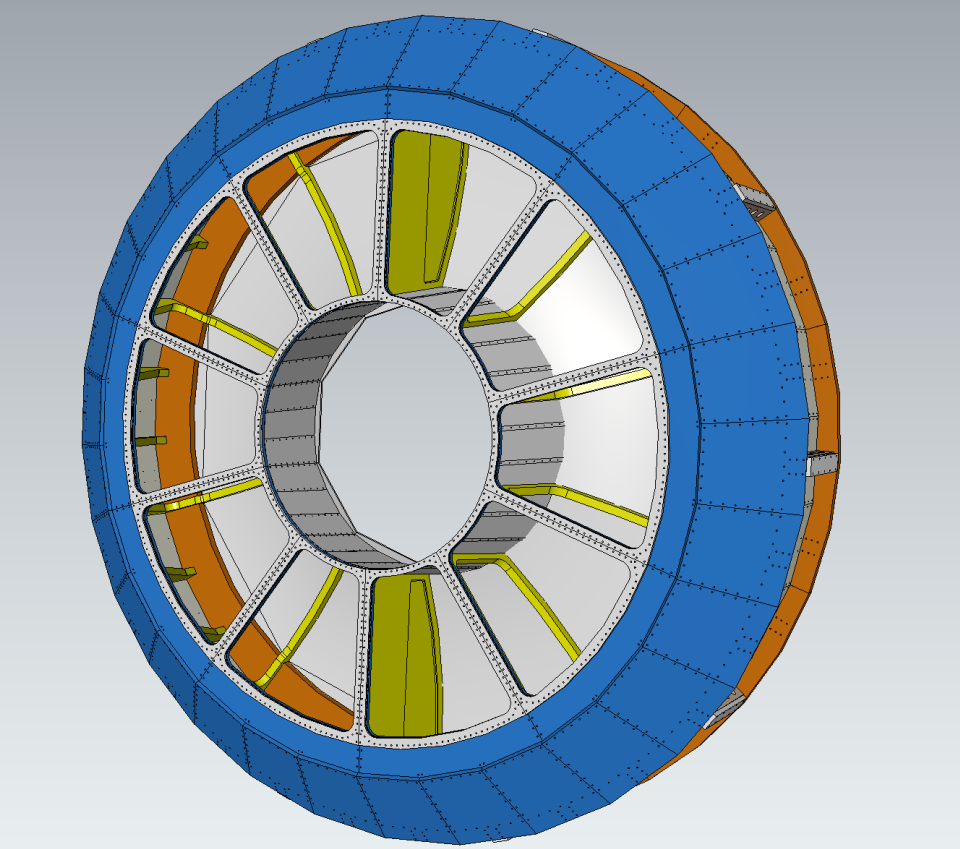
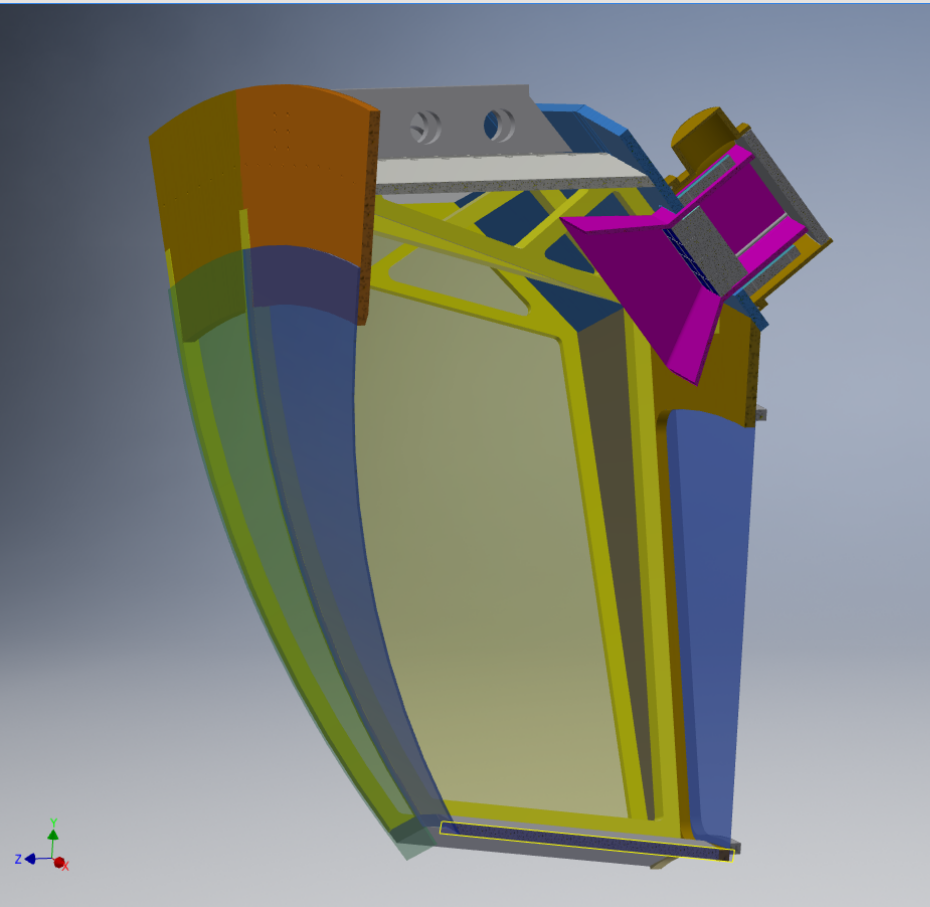
The SoLID Heavy Gas Cherenkov (HGC) is being constructed by a collaboration of: Duke University (NC), University of Regina (Canada), Stony Brook University (NY), and Mississippi State University (MS). The University of Regina is responsible for the HGC pressure vessel, which has the conflicting design requirements of being sufficiently strong to safely hold the 1.7 atm of C4F8 gas with minimal leakage, while also presenting a minimum of inactive material to the charged particles traversing the detector.
SoLID is currently in an advanced state of R&D. A Pre-R&D plan to help steer the detector design and better define the budget contingency has been completed, with the Cherenkov reports closed and accepted by USDOE. Following the official announcement of SoLID construction funding, we expect a further 2 years of advanced project engineering and design (PED), with the construction of long-lead time items starting in late 2025. The main SoLID construction would then begin in 2026. We expect construction to take 3 years, completed by the end of 2029. Installation of the SoLID components into JLab Hall A would take one year, with the start of the SoLID physics program expected to start in 2031.
4c. Deep Exclusive Meson Production studies with SoLID
The development of the Generalized Parton Distribution (GPD) formalism is a notable advance in our understanding of the structure of the nucleon. GPDs unify the concepts of parton distributions and hadronic form factors, and are ''universal objects'' that provide a comprehensive framework for describing the quark and gluon structure of the nucleon. GPDs are probed through Deep Exclusive reactions, and their knowledge would allow a tomographic 3D understanding of the nucleon to be built up.
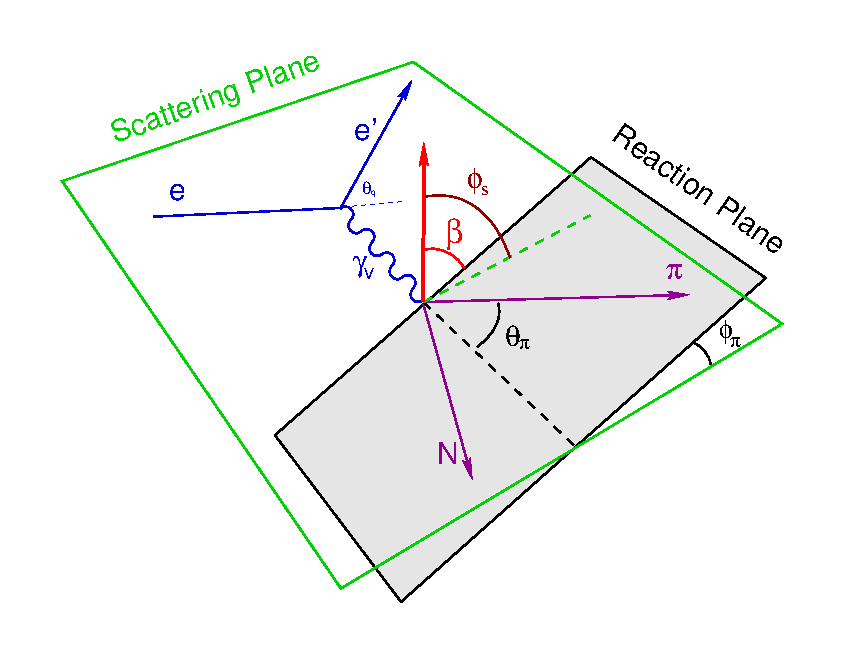
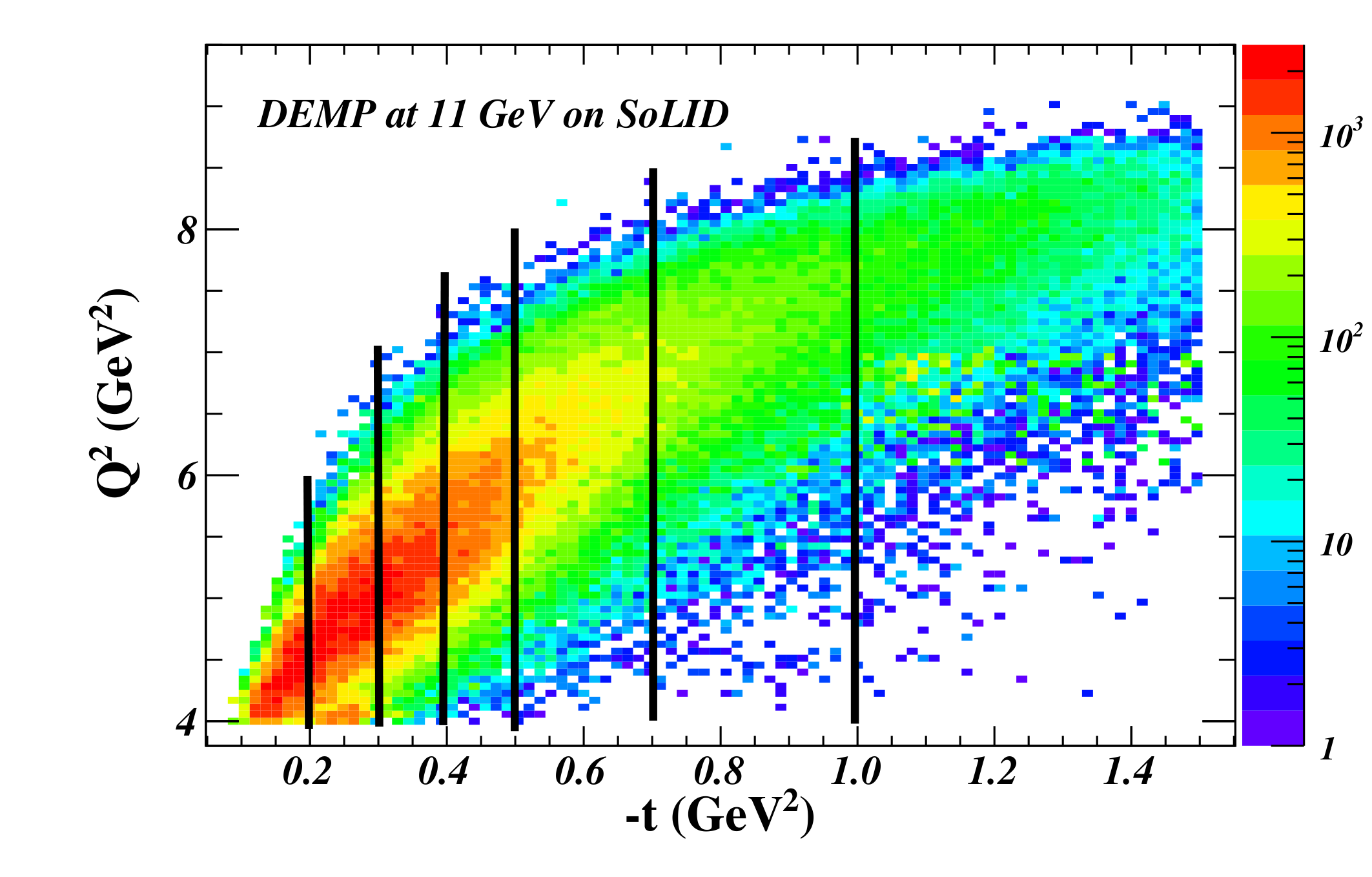
5. Preparations for the Electron-Ion Collider (EIC)
5a. The EIC science program in brief
The Electron-Ion Collider (EIC) is a major new collider facility to be built on Long Island, New York, by the US Department of Energy, with the flexibility to change the nuclear ion species as well as the beam energies. For electron-proton collisions, the Electron-Ion Collider (EIC) would be the world's first collider where both beams are polarized. The EIC luminosity is proposed to be 100-1000 times that of the former HERA accelerator at DESY. The projected completion date of the EIC is approximately 2031.

- How does the mass of the nucleon arise?
- How does the spin of the nucleon arise?
- What are the emergent properties of dense systems of gluons?
5b. Meson form factors as probe of emergent mass generation in hadrons
Through EIC Canada, we are one of the Canadian groups involved in bringing the EIC experimental program to fruition. Our work is most closely tied to the first question. The problem is that while gluons have no mass, and u, d quarks are nearly massless, the nucleons that contain them are heavy; the total mass of a nucleon is some 100 times greater than the mass of the valence quarks it contains. The largest contribution to the mass of the proton originates from the gluon field energy. In this sense, the source of visible mass in the universe is not the Higgs field, but the gluon field. Thus, more than 98% of the visible mass of the universe emerges as a consequence of strong interactions within QCD, through the mechanism tied to Dynamical Chiral Symmetry Breaking (DCSB).
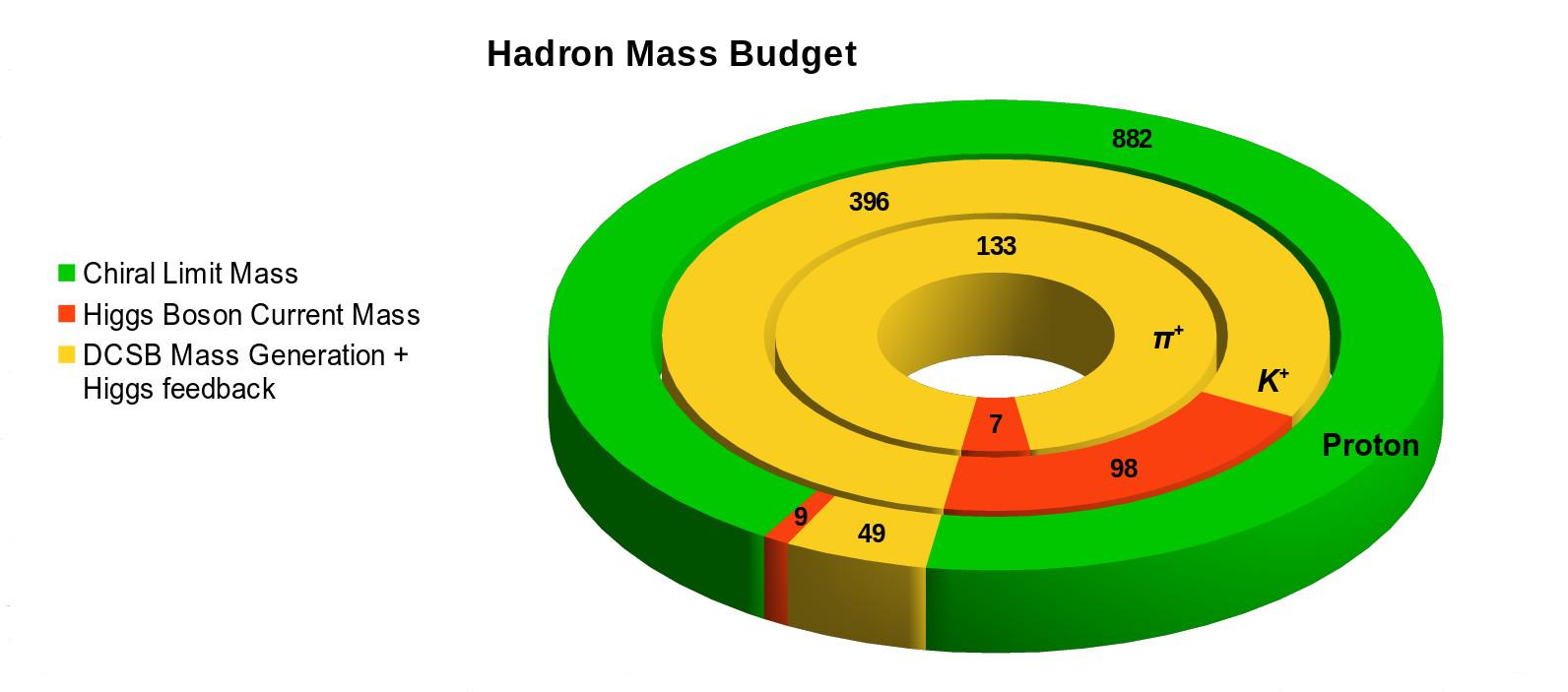
At the EIC, the pion form factor measurements we are pursuing at JLab can be extended to much larger Q2, by measuring ratios of positively- and negatively-charged pions in quasi-elastic electron-pion (off-shell) scattering via the p(e,e'π+)n and n(e,e'π-)p reactions, accessed with proton and deuterium beams. We have written an event generator and have performed simulations demonstrating the feasibility of these measurements. The measurements would be over a range of small ât, and gauged with theoretical and phenomenological expectations, to again verify the reliability of the pion form factor extraction.
